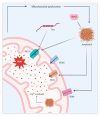Dysregulated Ca2+ Homeostasis as a Central Theme in Neurodegeneration: Lessons from Alzheimer's Disease and Wolfram Syndrome
- PMID: 35741091
- PMCID: PMC9221778
- DOI: 10.3390/cells11121963
Dysregulated Ca2+ Homeostasis as a Central Theme in Neurodegeneration: Lessons from Alzheimer's Disease and Wolfram Syndrome
Abstract
Calcium ions (Ca2+) operate as important messengers in the cell, indispensable for signaling the underlying numerous cellular processes in all of the cell types in the human body. In neurons, Ca2+ signaling is crucial for regulating synaptic transmission and for the processes of learning and memory formation. Hence, the dysregulation of intracellular Ca2+ homeostasis results in a broad range of disorders, including cancer and neurodegeneration. A major source for intracellular Ca2+ is the endoplasmic reticulum (ER), which has close contacts with other organelles, including mitochondria. In this review, we focus on the emerging role of Ca2+ signaling at the ER-mitochondrial interface in two different neurodegenerative diseases, namely Alzheimer's disease and Wolfram syndrome. Both of these diseases share some common hallmarks in the early stages, including alterations in the ER and mitochondrial Ca2+ handling, mitochondrial dysfunction and increased Reactive oxygen species (ROS) production. This indicates that similar mechanisms may underly these two disease pathologies and suggests that both research topics might benefit from complementary research.
Keywords: Alzheimer’s disease; Wolfram syndrome; calcium; mitochondria; mitochondria-associated ER membranes (MAMs); neurodegeneration.
Conflict of interest statement
The authors declare no conflict of interest.
Figures






Similar articles
-
Wolfram syndrome: MAMs' connection?Cell Death Dis. 2018 Mar 6;9(3):364. doi: 10.1038/s41419-018-0406-3. Cell Death Dis. 2018. PMID: 29511163 Free PMC article. Review.
-
ER calcium depletion as a key driver for impaired ER-to-mitochondria calcium transfer and mitochondrial dysfunction in Wolfram syndrome.Nat Commun. 2024 Jul 21;15(1):6143. doi: 10.1038/s41467-024-50502-x. Nat Commun. 2024. PMID: 39034309 Free PMC article.
-
Mitochondrial Ca2+ handling in Huntington's and Alzheimer's diseases - Role of ER-mitochondria crosstalk.Biochem Biophys Res Commun. 2017 Feb 19;483(4):1069-1077. doi: 10.1016/j.bbrc.2016.07.122. Epub 2016 Jul 30. Biochem Biophys Res Commun. 2017. PMID: 27485547 Review.
-
ER-mitochondria cross-talk is regulated by the Ca2+ sensor NCS1 and is impaired in Wolfram syndrome.Sci Signal. 2018 Oct 23;11(553):eaaq1380. doi: 10.1126/scisignal.aaq1380. Sci Signal. 2018. PMID: 30352948
-
The Role of Mitochondrial Calcium Homeostasis in Alzheimer's and Related Diseases.Int J Mol Sci. 2020 Dec 1;21(23):9153. doi: 10.3390/ijms21239153. Int J Mol Sci. 2020. PMID: 33271784 Free PMC article. Review.
Cited by
-
Mitigating neuroinflammation in cognitive areas: exploring the impact of HMG-CoA reductase inhibitor.Biochem J. 2024 Nov 20;481(22):1585-1602. doi: 10.1042/BCJ20240217. Biochem J. 2024. PMID: 39466125
-
Mitochondrial Ca2+ Signaling and Bioenergetics in Alzheimer's Disease.Biomedicines. 2022 Nov 24;10(12):3025. doi: 10.3390/biomedicines10123025. Biomedicines. 2022. PMID: 36551781 Free PMC article. Review.
-
Endoplasmic reticulum stress-related deficits in calcium clearance promote neuronal dysfunction that is prevented by SERCA2 gene augmentation.Cell Rep Med. 2024 Dec 17;5(12):101839. doi: 10.1016/j.xcrm.2024.101839. Epub 2024 Nov 29. Cell Rep Med. 2024. PMID: 39615485 Free PMC article.
-
Mitochondria-Associated Membranes: A Key Point of Neurodegenerative Diseases.CNS Neurosci Ther. 2025 May;31(5):e70378. doi: 10.1111/cns.70378. CNS Neurosci Ther. 2025. PMID: 40406921 Free PMC article. Review.
-
Reciprocal rescue of Wolfram syndrome by two causative genes.EMBO Rep. 2025 May;26(9):2459-2482. doi: 10.1038/s44319-025-00436-2. Epub 2025 Apr 3. EMBO Rep. 2025. PMID: 40181095 Free PMC article.
References
Publication types
MeSH terms
Substances
LinkOut - more resources
Full Text Sources
Medical
Miscellaneous

